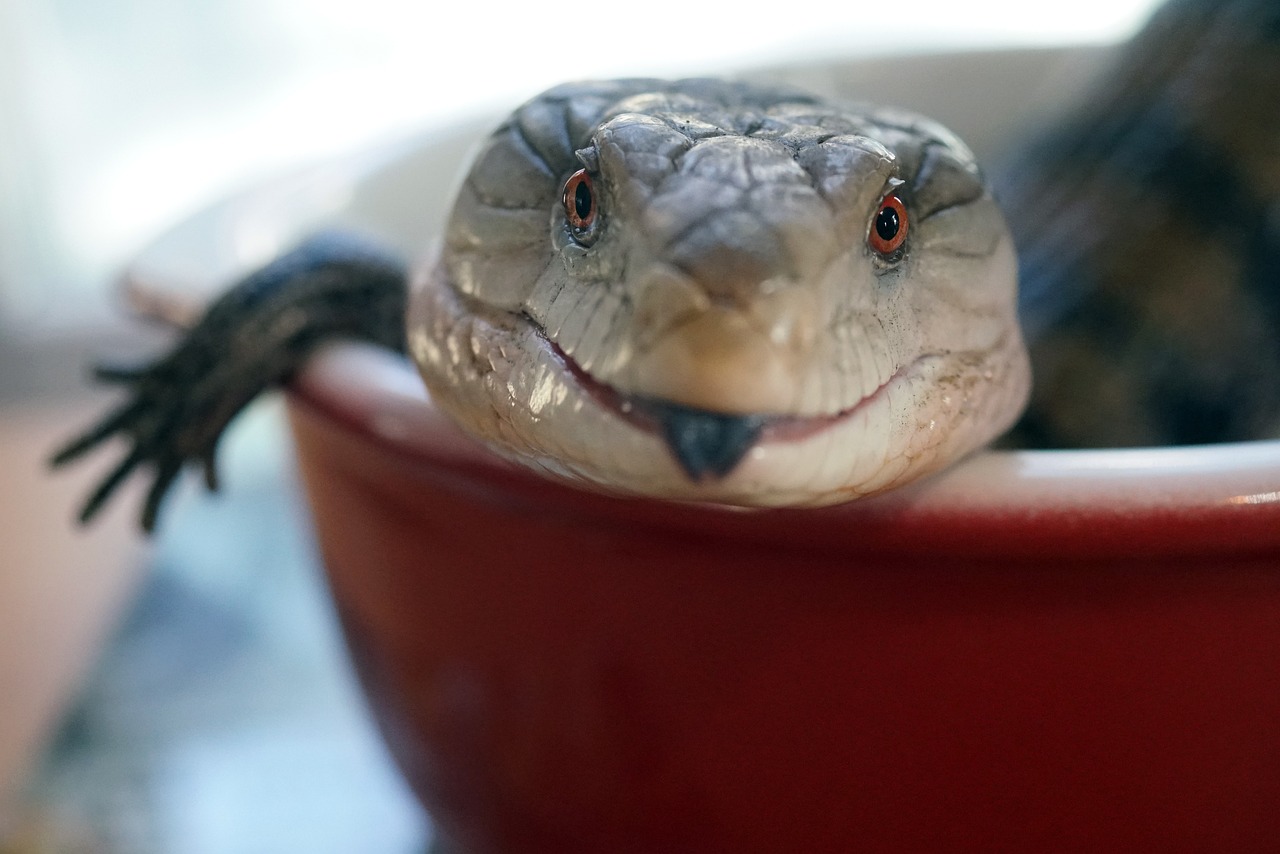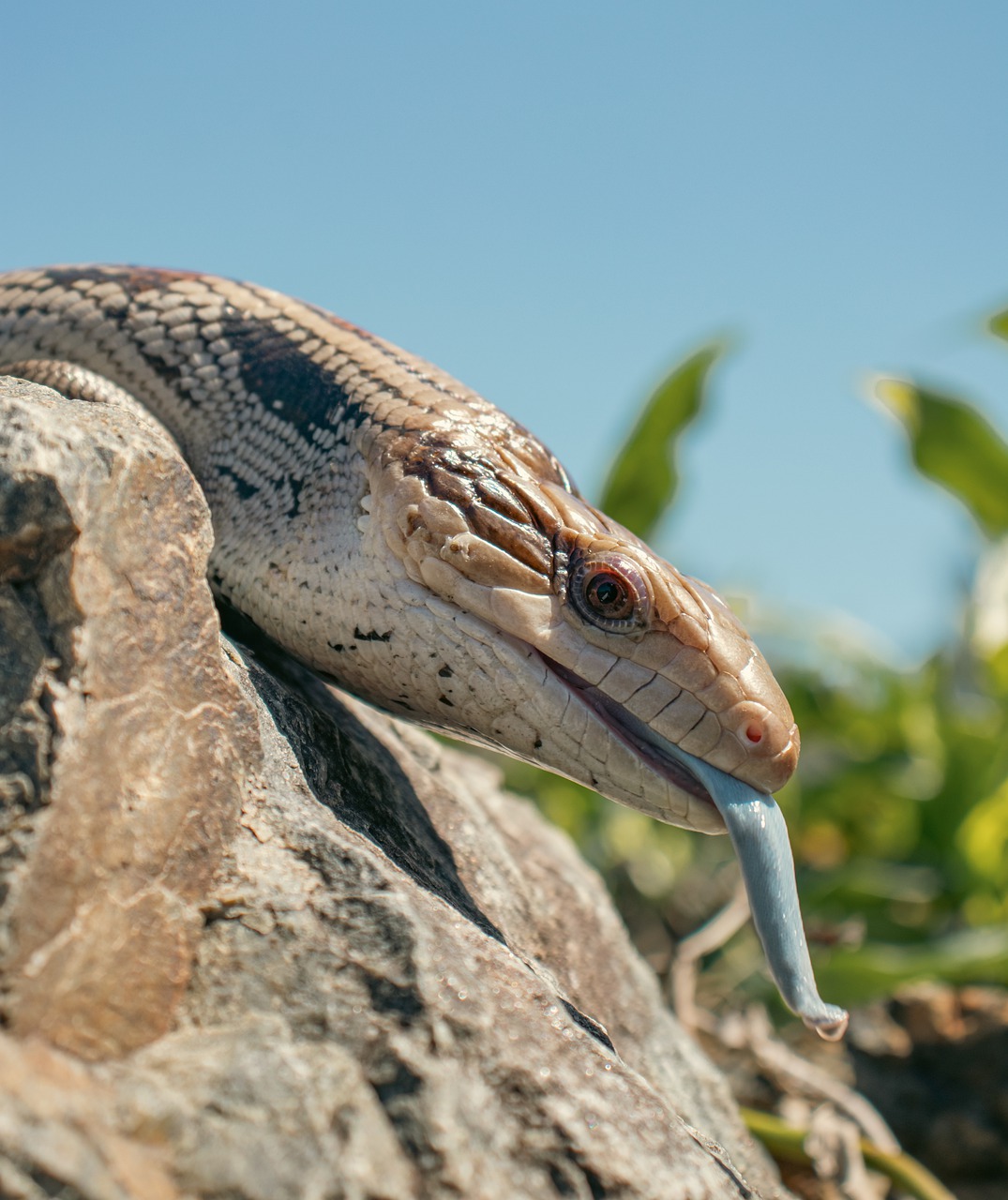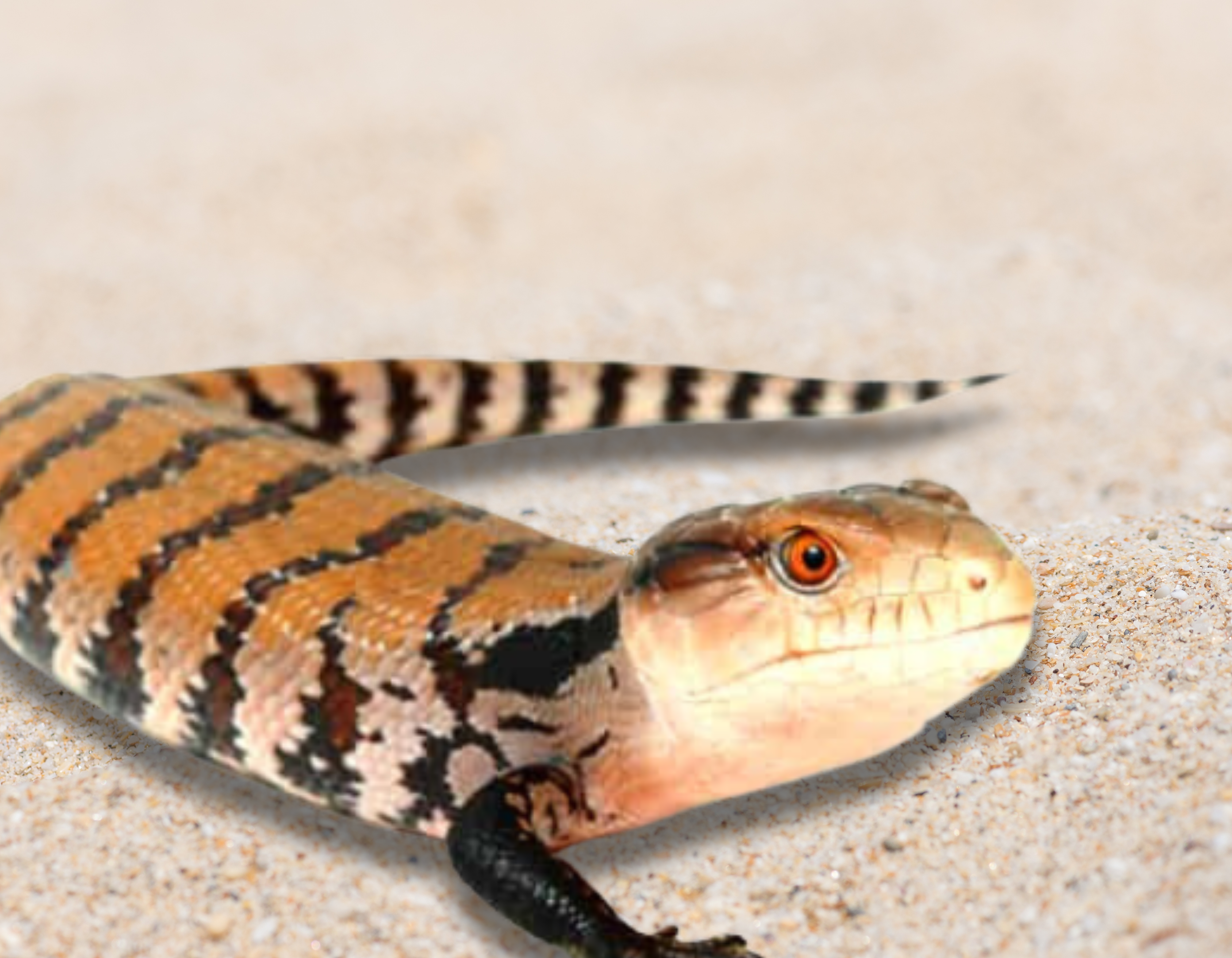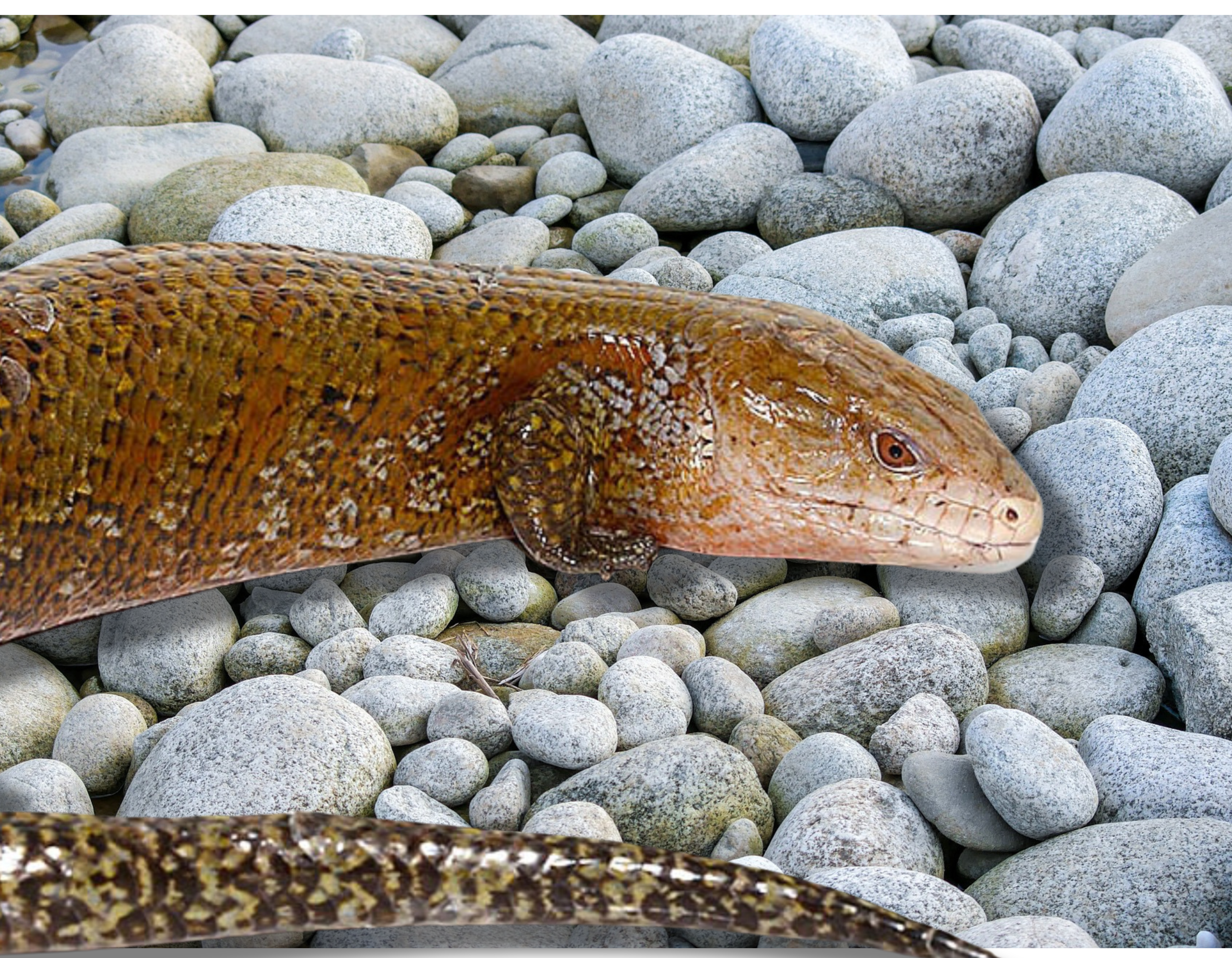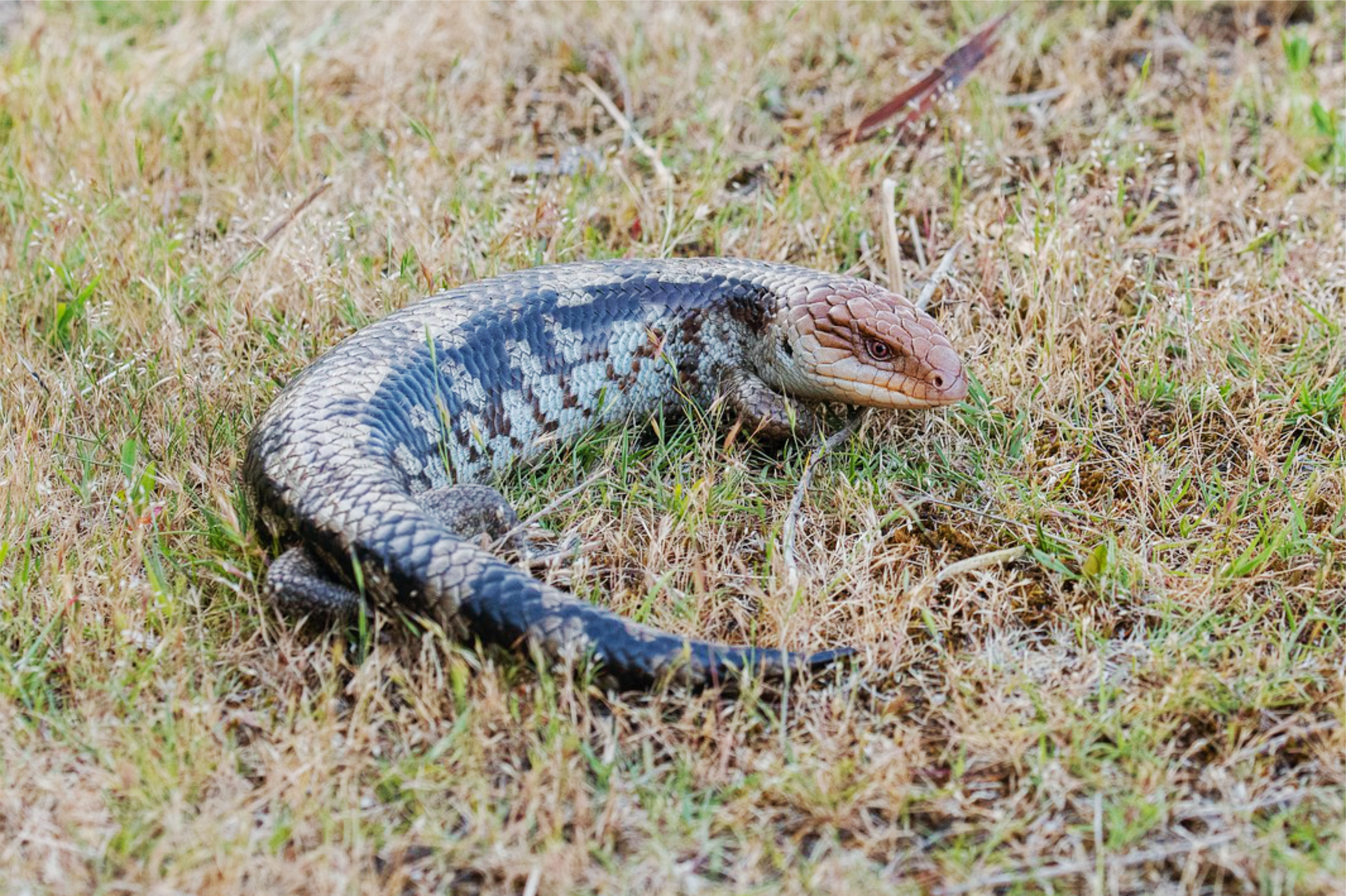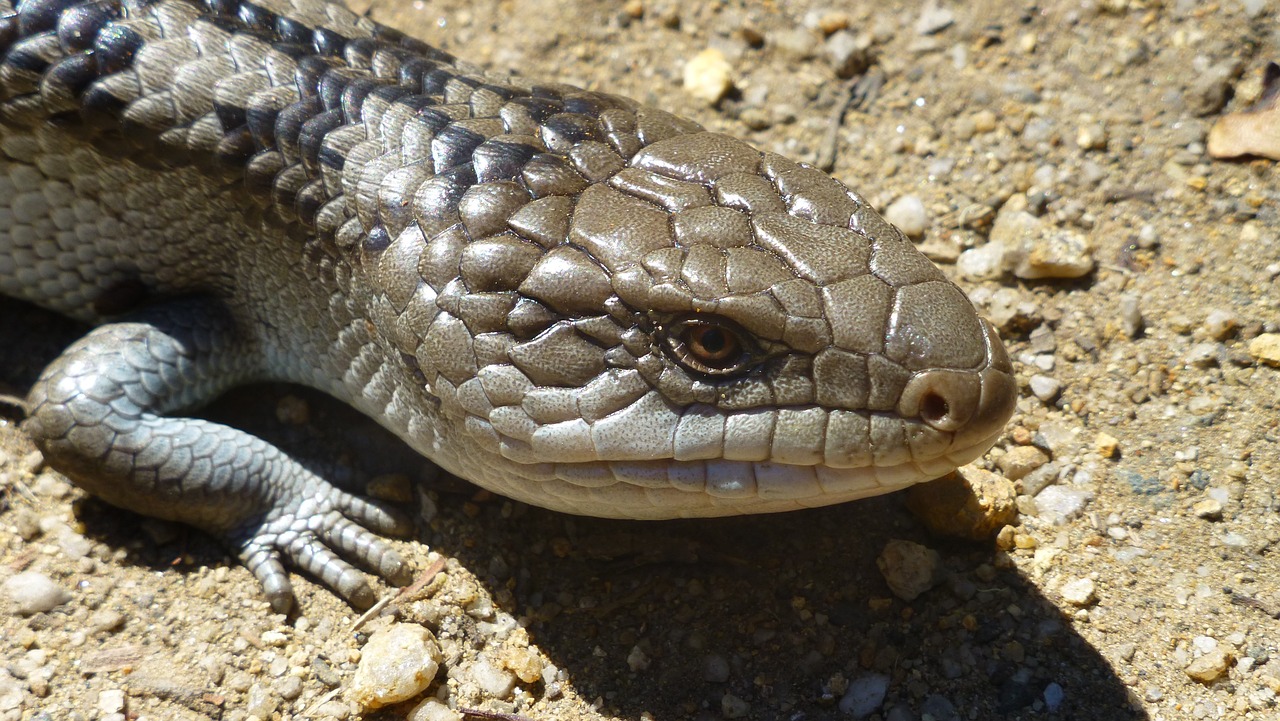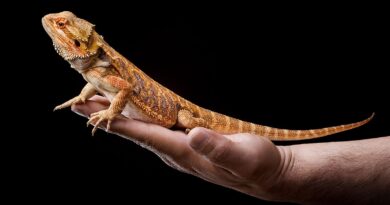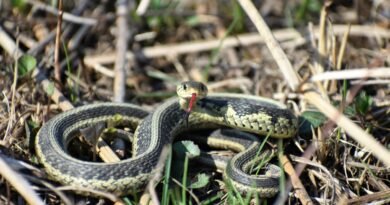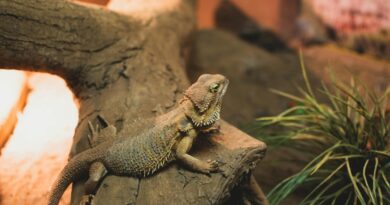All About The Giant Blue Tongue Skink
What is a Blue Tongue Skink?
Blue tongue skinks, also known as blue-tongued skinks, are fascinating lizards that belong to the skink family. They are named after their unique characteristic of having a bright blue tongue, which they can stick out for defensive purposes. Blue tongue skinks are native to Australia and Indonesia, and there are several different species and subspecies of blue tongue skinks, each with their own distinct features and habitats. These reptiles are popular in the pet trade due to their docile nature and relatively easy care requirements. In this article, we will explore the various species of blue tongue skinks, their behaviors, care needs, and why they make great pet lizards. So, let’s dive into the world of these fascinating creatures and learn more about the amazing blue-tongue skinks!
Features of the Giant Blue Tongue Skink
The Giant Blue Tongue Skink is a remarkable reptile known for its unique features and characteristics. As the name suggests, this skink is notable for its large body size, growing up to 18 inches in length. It showcases a range of colorations, from shades of gray and brown to a stunning blend of blue and black. These colors create an eye-catching and distinctive appearance, making the Giant Blue Tongue Skink stand out among other lizard species.
One of the most fascinating traits of this skink is its bright blue tongue. When threatened, the skink opens its mouth wide, revealing the vibrant blue coloration. This serves as a defense mechanism against potential predators, as it startles them and indicates poison or danger. The blue tongue is an effective deterrent, aiding the skink in warding off potential threats in the wild.
In addition to its blue tongue, the Giant Blue Tongue Skink bears black bands along its body, which enhance its overall appearance. These bands add a touch of contrast to the skink’s coloration, creating a visually striking pattern. Another distinguishing feature of this skink is its wide ear canals, allowing it to have a keen sense of hearing and navigate its surroundings with ease.
Overall, the Giant Blue Tongue Skink captivates with its sizable body, captivating coloration, and unique features such as the blue tongue, black bands, and wide ear canals. These characteristics make it an intriguing and sought-after reptile among reptile enthusiasts and pet keepers alike.
Varieties of the Giant Blue Tongue Skink
The giant blue tongue skink, scientifically known as Tiliqua gigas, is a fascinating reptile that belongs to the skink family. The species comes in a wide variety of subspecies with unique characteristics and colorations.
Some of the most notable varieties include the Indonesian blue-tongued skink, Tiliqua gigas gigas, native to the Indonesian islands such as Kei and Aru Islands. The Irian Jaya blue-tongued skink, Tiliqua gigas keyensis, is another commonly kept subspecies in the pet trade, originating from the Irian Jaya region in Indonesia.
Indonesian Blue-Tongued Skink (Tiliqua gigas)
The Indonesian Blue-Tongued Skink (Tiliqua gigas) is a fascinating reptile species that is highly sought after in the pet trade and revered by reptile enthusiasts. This unique lizard is known for its striking physical appearance and wide distribution across the Indonesian islands.
The Indonesian Blue-Tongued Skink, or Tiliqua gigas, boasts a large and robust body, which can reach up to 24 inches in length. Its most distinctive feature is its blue tongue, which it uses to startle potential predators. This adaptation, along with its black bands that run across its body, gives it a strikingly beautiful appearance.
This skink can be found in various Indonesian regions, including Kei Island, Irian Jaya, and Rottnest Island. It thrives in a range of habitats, from grasslands to forests, feeding on a diverse diet of fresh foods and feeder insects. It also prefers to live near water sources and leaf litter, where it can regulate its body temperature and find shelter.
One of the reasons why the Indonesian Blue-Tongued Skink is so popular in the pet trade is its docile nature and adaptability to captive environments. Its relatively large size and calm disposition make it an ideal pet lizard for reptile enthusiasts. Additionally, its unique appearance and interesting behaviors, such as its mouth wide and ear canals, are highly appealing to pet owners.
Within the Indonesian Blue-Tongued Skink species, there are several recognized subspecies, each with its own distinct features. These include Tiliqua gigas keyensis and Tiliqua gigas evanescens, among others. These subspecies have slight variations in their physical appearance and geographical distribution, adding to the appeal and diversity of this remarkable reptile.
In conclusion, the Indonesian Blue-Tongued Skink is a captivating reptile species that has gained significant popularity in the pet trade. Its physical appearance, wide distribution, and unique characteristics make it a favorite among reptile enthusiasts. With its various subspecies, such as Tiliqua gigas keyensis and Tiliqua gigas evanescens, this skink offers a wide range of options for those looking to own a remarkable and beautiful reptile pet.
Kei Island Blue-Tongued Skink (Tiliqua gigas gigas)
The Kei Island Blue-Tongued Skink (Tiliqua gigas gigas) is a remarkable lizard species known for its unique characteristics and striking appearance. This subspecies, native to the Indonesian Kei Islands, is a member of the skink family and is highly sought after by reptile enthusiasts.
When fully grown, the Kei Island Blue-Tongued Skink can reach an average size of 18 to 20 inches in length. It boasts a robust body with a relatively large head, short limbs, and a thick tail. The most notable feature of this skink is its stunning blue tongue, which provides it with its common name.
In terms of natural habitat, Kei Island Blue-Tongued Skinks prefer the tropical environments of their Indonesian islands. They thrive in diverse ecosystems that consist of forested areas, leaf litter, and water sources such as pools or bowls. These skinks have adapted well to their surroundings and are known to forage for a wide variety of food, including feeder insects, fresh fruits, and even cat food.
With a docile nature, the Kei Island Blue-Tongued Skink is an excellent choice for pet keepers. They tend to be friendly and can be easily handled with care. Additionally, they have certain traits specific to this subspecies, such as distinct black bands across their body, wide ear canals, and an ability to regulate their body temperature efficiently.
In conclusion, the Kei Island Blue-Tongued Skink (Tiliqua gigas gigas) is a captivating reptile species known for its unique characteristics, size, and appearance. Its adaptability to various habitats and friendly temperament make it a popular choice for reptile enthusiasts and pet keepers alike.
Merauke Blue-Tongued Skinks (Tiliqua scincoides chimaerea)
The Merauke Blue-Tongued Skink, scientifically known as Tiliqua scincoides chimaerea, is a fascinating lizard species that captivates reptile enthusiasts with its unique characteristics. These skinks can be found in the Indonesian islands, specifically in the Merauke region of Papua New Guinea.
Merauke Blue-Tongued Skinks are known for their large size, reaching up to 60 centimeters in length. They have a robust body and a striking blue tongue, which they use as a defense mechanism to deter predators. These skinks also possess distinctive black bands across their body, adding to their allure.
In terms of habitat, Merauke Blue-Tongued Skinks prefer tropical rainforests and lush grasslands. They are mostly terrestrial but are also skilled climbers. These skinks have adaptive behaviors and are diurnal, meaning they are active during the day.
When it comes to feeding, Merauke Blue-Tongued Skinks have a wide variety of dietary preferences. They primarily eat invertebrates such as snails, insects, and worms. Additionally, they consume plant matter, including fruits and vegetables. A well-balanced diet consisting of fresh foods is crucial for their overall health.
Caring for Merauke Blue-Tongued Skinks involves providing them with an appropriate enclosure, complete with hiding spots, a water bowl for hydration, and leaf litter for natural enrichment. Keeping their habitat warm is essential since they rely on external heat sources to regulate their body temperature. Regular vet check-ups are also recommended to ensure they are free from parasites or any health concerns.
Overall, Merauke Blue-Tongued Skinks are captivating reptile pets with their unique characteristics, specific habitat requirements, and varied dietary preferences. Their striking appearance and docile nature make them a popular choice for reptile keepers.
Northern Blue-Tongued Skinks ( Tiliqua scincoides intermedia)
The Northern Blue-Tongued Skinks, scientifically known as Tiliqua scincoides intermedia, are a variety of blue-tongued skink that possess some unique characteristics, making them a popular choice among reptile enthusiasts. They are characterized by their large size and robust build, with adults reaching lengths of up to 60 centimeters.
Native to Australia, particularly in the northern parts of Queensland, the Northern Blue-Tongued Skinks have specific habitat preferences. They can be found in a wide range of environments, from arid woodlands to rainforests and even suburban gardens. These skinks are highly adaptable and can adjust to different climates, making them a suitable pet lizard for many reptile keepers.
What distinguishes the Northern Blue-Tongued Skinks from other varieties is their distinct coloration. They typically have a mix of dark brown and grayish-blue scales, with black bands across their bodies. Their most notable feature, however, is their vibrant blue tongue. When threatened, these skinks will open their mouths wide, displaying their striking blue tongues as a warning signal.
Behaviorally, Northern Blue-Tongued Skinks are known for their docile and friendly nature. They are generally calm and easy to handle, which makes them popular pets for both beginners and experienced reptile keepers. They have a wide variety of dietary preferences, feeding on a mix of fresh foods such as fruits, vegetables, and even cat food.
In conclusion, the Northern Blue-Tongued Skinks (Tiliqua scincoides intermedia) are distinctive in their appearance and behavior. With their unique blue tongues, adaptability to various habitats, and friendly temperament, these skinks have become a favorite among pet reptile enthusiasts.
Care Requirements for a Giant Blue Tongue Skink
Giant Blue Tongue Skinks are fascinating reptiles with unique care requirements and they require spacious enclosures and a balanced diet to thrive. In order to maintain their health, it is crucial to replicate their natural habitat by providing a warm and humid environment, supplemented with UVB lighting. Giant Blue Tongue Skinks are omnivores, so their diet should consist of both animal protein and plant matter. They enjoy feasting on feeder insects, such as crickets and mealworms, as well as fresh foods like fruits and vegetables. Also, providing a water bowl and a suitable substrate, such as leaf litter, is essential for their well-being. Regular veterinary check-ups and inspections for parasites, such as ticks, are also important. By providing proper care and plenty of food, these fascinating creatures can make wonderful reptile pets for enthusiasts and keepers alike.
Temperature and Humidity Levels
Maintaining the appropriate temperature and humidity levels is essential for ensuring the well-being of a Giant Blue Tongue Skink in captivity. These reptiles require specific conditions to thrive and remain healthy.
The ideal temperature range for a Giant Blue Tongue Skink is between 80°F to 90°F (27°C to 32°C) on the warm side of the enclosure and 70°F to 80°F (21°C to 27°C) on the cool side. It is important to provide a temperature gradient, allowing the skink to regulate its body temperature as needed.
Consistent humidity levels are also crucial for these skinks. Aim for a humidity level of 40% to 60% in their enclosure. This can be achieved by providing a shallow water bowl for them to soak in, as well as misting the enclosure daily.
To ensure the skink’s well-being, it is vital to adhere to specific temperature and humidity requirements. A digital thermometer and hygrometer can be used to monitor these levels accurately. Providing a warm basking spot with a heat lamp or heating pad is necessary, along with proper ventilation to prevent excessive moisture buildup.
Maintaining ideal conditions with proper temperature and humidity levels is essential for the health and happiness of your Giant Blue Tongue Skink. Regularly monitoring and adjusting these factors will help ensure a comfortable environment for your pet.
Habitat Setup and Enclosure Size
When setting up the habitat for your Giant Blue Tongue Skink, it is important to create an environment that mimics their natural habitat. These skinks are native to the Indonesian islands, and they require certain conditions to thrive.
To ensure the health and well-being of your skink, the enclosure should be spacious enough to allow for movement. A minimum enclosure size for a single adult skink is 36 inches long, 18 inches wide, and 12 inches tall. However, providing a larger enclosure is always better.
The ideal habitat setup includes a warm basking spot with a temperature gradient ranging from 75-85°F on the cooler side and 90-100°F on the warmer side. The humidity levels should be kept between 40% and 60%, with occasional misting to provide moisture.
In terms of substrate, a mix of reptile-safe soil and sand works well, along with leaf litter for a natural feel. Provide a water bowl large enough for your skink to soak in and maintain proper hydration.
For optimal health, offer a varied diet consisting of commercially available feeder insects, fresh foods, and occasional cat food. It is important to feed a wide variety to ensure proper nutrition.
By following these guidelines and creating the ideal habitat conditions, you can provide a comfortable and stimulating environment for your Giant Blue Tongue Skink.
Feeding Habits and Diet Needs
The Giant Blue Tongue Skink is a fascinating reptile known for its unique feeding habits and specific diet needs. As a member of the skink family, this species requires a varied and balanced diet to thrive.
Blue-tongued skinks are omnivores, which means they eat both animal protein and plant matter. In the wild, their diet consists of a wide variety of food sources, including insects, worms, snails, fruits, and vegetables. This diversity is crucial for ensuring they receive all the necessary nutrients.
When kept as pets, it is important to replicate their natural diet as closely as possible. Providing a mix of commercial diets, such as cat food formulated for omnivorous reptiles, along with fresh foods like fruits, vegetables, and feeder insects, ensures they receive the necessary nutrients. It is also important to offer a water bowl for hydration.
A varied diet is not only essential for their overall health and well-being, but it also helps prevent nutritional deficiencies. The skink’s diet should consist of approximately 50-60% animal protein and 40-50% plant matter. This balance ensures they receive the right amount of essential nutrients such as calcium, vitamins, and minerals.
In conclusion, the Giant Blue Tongue Skink requires a varied diet that includes both animal protein and plant matter. By providing a wide range of food sources, reptile enthusiasts can ensure their pet skinks receive the necessary nutrients for optimal health.
Handling and Interaction with Your Pet Lizard
Handling and interacting with your pet giant blue tongue skink can be a rewarding experience for both you and your reptile companion. However, it’s important to remember that these creatures require gentle handling and proper support to ensure their safety and well-being.
When handling your blue tongue skink, always approach them slowly and calmly to avoid causing any unnecessary stress. Support their body properly by gently scooping them up from underneath, making sure to fully support their entire body. This helps them feel secure and reduces the risk of injury.
Bonding with your lizard can be achieved through regular handling and positive interactions. Spend time with your pet, allowing them to explore your hands and get used to your touch. This helps them become comfortable with human interaction and can strengthen your bond over time.
In addition to handling, there are other enjoyable activities you can engage in with your blue tongue skink. These lizards are known for their curious nature, so providing them with a stimulating environment will keep them happy and entertained. You can create an enriching habitat with plenty of hiding spots, branches to climb on, and opportunities for basking.
Interacting with your pet lizard can also include offering fresh food items, such as fruits, and vegetables, and lean protein sources like cooked chicken or cat food. You can also provide them with a water bowl for hydration, as well as leaf litter for them to explore and burrow in.
Remember, handling and interacting with your giant blue tongue skink should always be done with care and respect for their well-being. With gentle handling and positive interactions, you can develop a strong bond with your pet lizard that will last a lifetime.
Common Health Issues in Giant Blue Tongue Skinks
Known for their wide variety of colors, patterns, and characteristics, these Australian reptiles have become popular pets in the pet trade. With names like the Indonesian blue-tongued skink, Tiliqua gigas, and Tiliqua gigas gigas, these lizards can be found in different regions, such as the Kei Island, Irian Jaya, and Merauke. While giant blue tongue skinks are generally hardy and resilient, they can still experience certain health issues. It is essential for reptile enthusiasts and pet owners to be aware of these common health problems to ensure the well-being of their beloved blue tongue skinks. By understanding and addressing these issues, such as parasites, respiratory infections, and nutritional deficiencies, reptile keepers can provide the necessary care and attention to maintain their pet skinks’ overall health and happiness.
Metabolic Bone Disease (MBD)
Metabolic Bone Disease (MBD) is a common condition that can affect Giant Blue Tongue Skinks when they do not receive proper nutrition and calcium supplementation. MBD is caused by a lack of calcium, vitamin D, or both, which are essential for healthy bone formation and maintenance.
Symptoms of MBD in Giant Blue Tongue Skinks include a soft jaw, swollen limbs, deformities in the legs and spine, tremors, and difficulty moving. In severe cases, it can lead to paralysis and death. If you suspect your skink has MBD, it is crucial to seek veterinary care immediately.
Treatment options for MBD in Giant Blue Tongue Skinks typically involve correcting the underlying calcium and vitamin D deficiencies. This may include dietary changes, calcium and vitamin D supplementation, and appropriate exposure to natural sunlight or UVB lighting.
Preventing MBD in Giant Blue Tongue Skinks is essential. Providing a balanced diet that includes a wide variety of foods, such as feeder insects, fresh fruits and vegetables, and commercially available blue tongue skink diets, is crucial. Additionally, ensuring adequate calcium supplementation and proper exposure to UVB lighting can help prevent MBD.
In conclusion, Metabolic Bone Disease is a serious condition that can affect Giant Blue Tongue Skinks. Early detection and treatment are vital. Proper nutrition, including calcium supplementation, and access to natural sunlight or UVB lighting are key to preventing and managing MBD in these reptiles.
Parasites, Nutritional Deficiencies, Respiratory Problems, etc.
Giant blue tongue skinks, also known as blue-tongued skinks, are fascinating reptiles that require proper care to maintain their health. Like any other pet, they can experience common health issues such as metabolic bone disease (MBD), parasites, nutritional deficiencies, and respiratory problems.
Metabolic bone disease is a condition caused by a lack of calcium and vitamin D3 in the skink’s diet. This deficiency leads to weakened bones, deformities, and difficulty in movement. Symptoms of MBD include softening of the jaw and limb bones, swollen or misshapen limbs, and difficulty in shedding skin. To treat MBD, owners should provide a calcium-rich diet, UVB lighting, and may consult a veterinarian for supplements.
Parasites can also afflict giant blue tongue skinks, including worms, ticks, and mites. These parasites can cause gastrointestinal issues, weight loss, lethargy, and skin irritation. Regular fecal exams and veterinary treatments are necessary to prevent and treat parasitic infestations.
Nutritional deficiencies occur when blue tongue skinks are not provided with a balanced diet. They rely on a wide variety of foods, including fresh vegetables, fruits, and proteins. Lack of essential nutrients can lead to issues such as poor growth, weakened immune system, and reproductive problems. A proper diet and supplementation can help address nutritional deficiencies.
Respiratory problems may occur if giant blue tongue skinks are kept in environments with poor ventilation or improper temperatures. Symptoms include wheezing, rapid breathing, nasal discharge, and lethargy. Maintaining suitable temperature and humidity levels, along with a well-ventilated enclosure, can prevent respiratory problems. If necessary, antibiotics and supportive care may be prescribed by a veterinarian.
It is essential for owners of giant blue tongue skinks to be aware of these common health issues, their causes, and potential treatment options. Regular monitoring, a balanced diet, and veterinary care are crucial for ensuring the well-being of this unique and captivating reptile.


